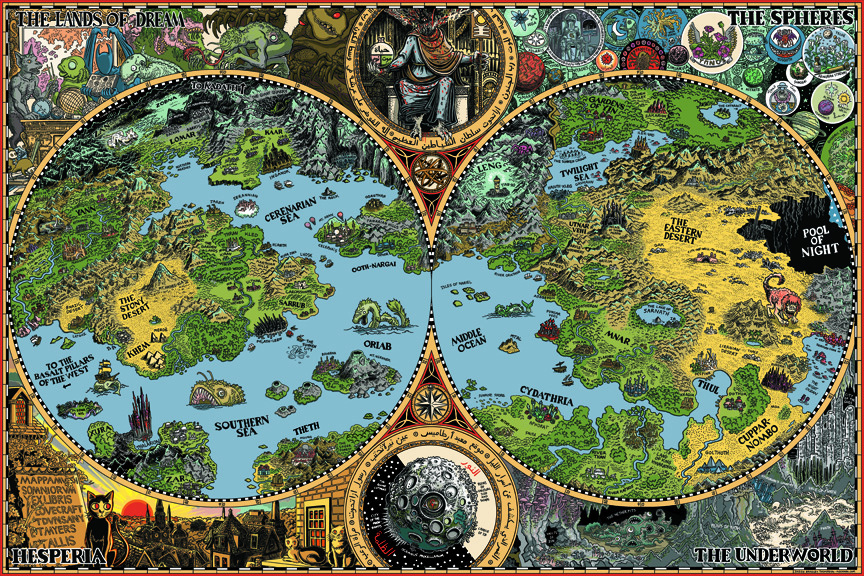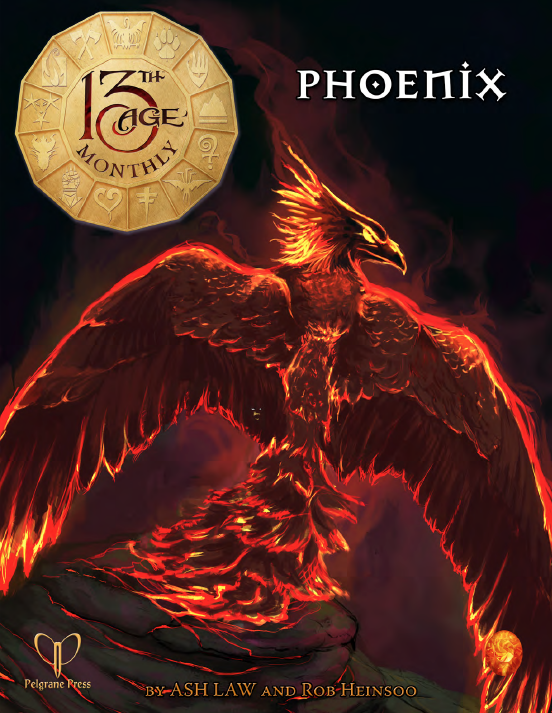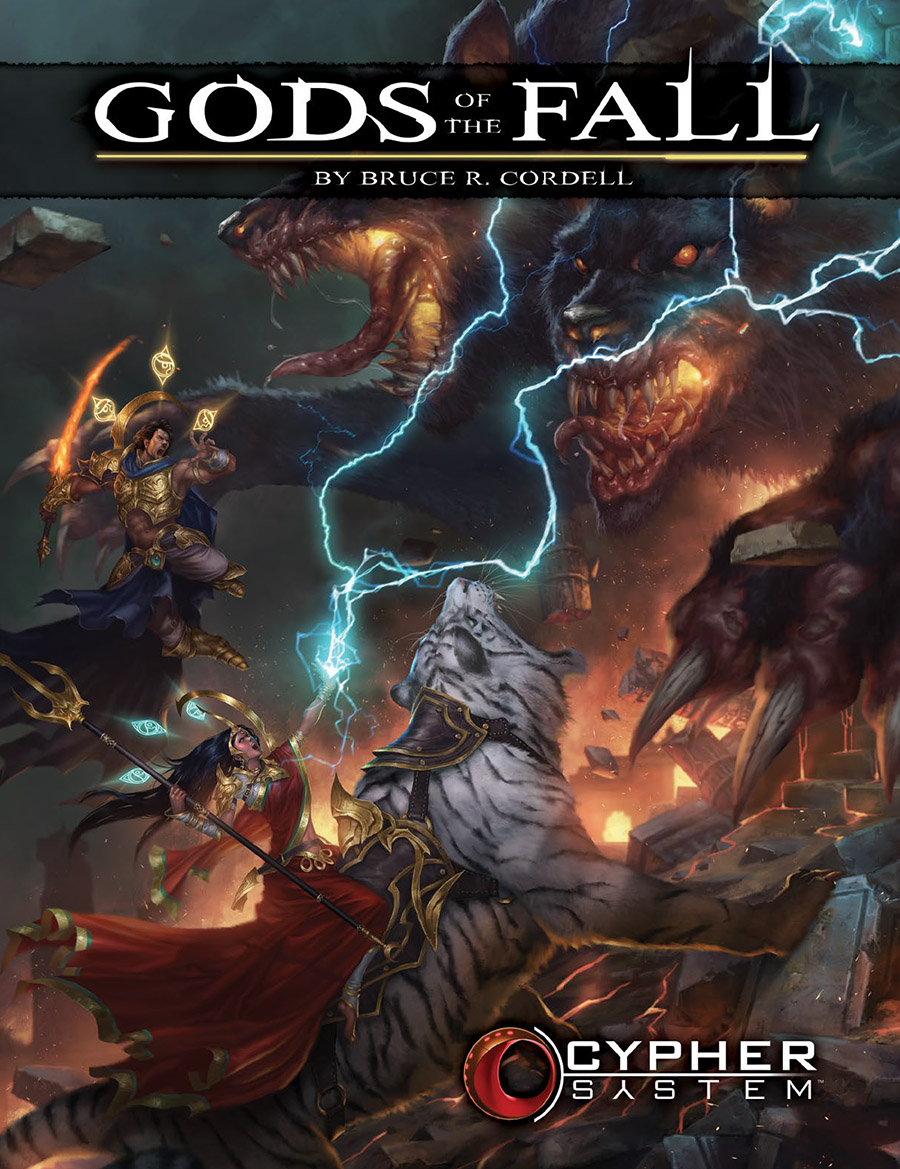Gods of the Fall
Chapter 1: Welcome to the Afterworld
The first chapter of Gods of the Fall goes a long way to
introducing both the game itself and the setting. The chapter is 12 pages long, minus 7
half-page spreads, leaving 8.5 pages of text to introduce the concepts of
nascently-divine PCs and the setting.
Per usual, the margins are annotated with references to other pages in the
book when new concepts are introduced.
When a mechanic from the Cypher System core book is referenced, it’s
also annotated with a special symbol, harkening back to locations for more
information. These margin notes also
give pronunciation guides for some of the new terms, which is wonderful for
really jumping into the setting.
Overall, I like this chapter as an introduction for players and for the
GM.
The first page starts with a great note that this book is an
expansion to the Cypher System rules and that it requires the core book to
play. I like this development and hope
that the physical book covers this as well.
When Green Ronin released their Titansgrave setting, they placed a notice
on the book’s back cover that the Fantasy AGE core book would be required. I’m working this review off of a PDF, so I
don’t have the back cover of Gods of the Fall.
But, I hope that Monte Cook has done something similar.
One neat idea that the book discusses is starting the game
with the players believing they are just normal PCs and working in the
dominion/divinity elements later. While
the information from this section could be used for a game where the PCs know
they’ll be developing into deities, even this chapter would have to be hidden
from players to do so. That said, this
is a great start for introducing players into the system—while still leaving
them wanting more.
Most importantly, by the end of this section, we’ve got the
most important information for playing: the Gods are dead, their overworld
crashed into the kingdom that was the center of civilization, there have been
42 years of chaos/trouble since the accident, there are new nascent gods who
have varying levels of acceptance, the new gods may or may not be a thing but
most people know some type of change is happening as recorded in some
prophecies, and there’s a group that exists to frustrate the return of divinity
to the setting. This is clear,
interesting, and puts the reader on notice that a lot is going on AND that the basic themes can be
reduced to a page or less.
Back and Forth Organization
The first chapter presents a lot of information, but it’s
organized in a somewhat confusing manner.
The first two sections in the chapter “PC Divinity” and “Darkness of the
Afterworld” really act more as introductions to more involved sections on
playing in the world and what the setting is like. While I understand the temptation to inform
the reader that the book will discuss these two concepts, I’d like to have seen
these sections subsumed into the later sections. There’s really great information in these
sections and splitting it off from the later, more in-depth sections means that
it will be more difficult to find some of these pieces of information later on.
Player Character-Focused Information
This is where we learn how the Cypher System mechanics will
interact with this specific fleshing out of the system’s generic rules. Obviously, the main conceit here is that the
PCs have (or will acquire) the ability to grow into true divine beings. This will manifest through a character to
take an ability beyond the normal descriptor, focus, and type: the
dominion. We learn that these creatures
have a nimbus, an aura that surrounds them.
Someone’s nimbus is always visible to other creatures with a nimbus and
can be manifested to others at will.
This reminds me of how the TV show Grimm
treats its wessen—most people can’t see them unless the wessen is manifesting
its supernatural abilities or the person observing the wessen is a Grimm.
We also learn that there is magic separate from the gods. That magic existed before the gods’ fall, though
the gods’ power kept them from exercising their powers to claim dominion over
the world. We learn that cyphers are
portions of the gods’ former floating realm or items that fell with it. We also learn that artifacts fit more into
the magic system. Finally, we learn
about the Seven Prophecies, seven suggested routes that can be used to help
focus a gods-driven campaign.
Setting Information
The technology is described so evocatively as being similar
to the Renaissance, but a Renaissance not based on the values of humanism. This is incredibly evocative, even before
Gods of the Fall transitions into discussing exactly what this means. Human life has basically become commoditized
unless an individual can defend themselves from enslavement, etc. This means gritty, dangerous stories. Aside from a tiny educated class, most people
are either dredges or outright slaves.
Now we’ve got a world ready for a revolt!
The first chapter also presents the basics of the setting:
what the world looks like and how people live.
There are five major geographical elements in the setting:
- · The Nightland: The most developed portion of the setting information (in this section), the Nightland is the heart of civilization since the gods’ realm crashed into and destroyed civilization’s former cradle. The Nightland exists in a state of eternal shadow, since a new moon appeared at the moment of the Fall and rotates between the earth and the sun to keep this region eternally in shadow. (Don’t worry, they thought about how crops get grown!) The Nightland is ruled by a dragon empress and divine power is outlawed; which is enforced by her Order of Reconciliation. The Nightland is a great place for urban adventures with a lot of intrigue.
- · Ruinscape: The Ruinscape is where the gods’ realm fell. There’s a new sea created at the crash site. The crash also exposed many ruins, some of which might actually pre-date the recently-fallen gods. Most exploration-style adventures will occur here. Another fun design decision is that most people living in civilized areas won’t even believe that some of the creatures in the Ruinscape even exist. One of my favorite parts of The Wheel of Time involves an encounter in the southlands, far from where the monsters are located. The travelers are telling tales of monsters of the north and an innkeeper says that those tales were as big lies as tales of snow. This was great worldbuilding and it’s great that in Gods of the Fall most people DON’T believe in some of these crazy things.
- · The Verge: The area was never really developed, even before the fall. It gives GMs a nice place to run wilderness adventures.
- · Nod: Nod is the moon that appeared when the gods’ home fell. It also appears to fill a role akin to the Dreamlands in H.P. Lovecraft’s writing. Depending on how this concept is further developed, could be extremely interesting. Nod also gives a strong campaign element that isn’t necessarily related to the reclamation of the divine.
- · Afterlife: Nobody knows where or what this is, but we all know that it’s not working the way it’s supposed to. Although this is denoted as a location, I like it more as a place the PCs never have to visit but instead deal with emanations from.
We learn a little bit about the history. Gods of the Fall has made what I consider to
be a fantastic design decision here. The
gods’ old realm fell 42 years ago. The
age before that was over 32,000 years long.
That means that there’s very little history for players to absorb. Only the last 42 years (and how they’ve
changed things vis-à-vis the previous 32K years) matter. 42 years ago, the gods’ realm fell from
heaven. There was lots of war and
chaos. Seven years later, the dragon
empress had solidified her rule over the Nightland. Since then, we’ve had a tense stability, but
certainly not peace. Done!
Gods of the Fall considers how most people deal with
religion based upon their age. Those who
can remember a time before the fall are angry.
Those who can’t just can’t comprehend what a world ruled by a pantheon
of gods was like. This appears to draw a
lot on the old Dragonlance setting, particularly the War of the Twins book that takes place shortly after the gods in
that setting destroyed the world and abandoned it. Whereas Dragonlance took 300 years to
consider the reengagement with religion, Good of the Fall is using only
42. Of course, Gods of the Fall is also
introducing new gods, which is a huge departure from the Dragonlance setting—one
that makes it more interesting, to me at least.
Regardless of how people might feel about the old gods and
accepting the new, people are wary of buying into them and this just feels right!
A good touch: formerly elaborate funeral rites have been replaced by
quick internments, because no one is really sure what happens after death—if anything
at all. We’re told that old temples and
religious sites have been repurposed into “chapterhouses,” dedicated to
contemplation, but not a lot about how they fit into the setting. Since the core of Gods of the Fall is about
engaging with the divine after your first conception of the divine has been
destroyed, I want to know about how people have changed their former places of
worship. Surely, a large number were
destroyed and now function as modern ruins.
This seems like a great place to set an introductory adventure, in fact.
Overall, this chapter provides a strong introduction to the
setting and the game itself. I’ve
glossed over a few areas, such as languages and two other playable races: treen
and sleen. Interestingly, there’s also
another sentient group, the nefar, who are called out as specifically not being
appropriate for PCs. The chapter also
introduces the Delirium, similar to the Iron Wind in Numenera. The Delirium spits of curses and is all sorts
of crazy. Basically, the first chapter
of Gods of the Fall takes what’s a very non-traditional setting and makes it
accessible to the player and the GM.
While I’ve nit-picked a little bit about the chapter’s organization,
overall I found it incredibly useful for bringing the setting to life. Ultimately, by using its (linked) margin
annotations, the book allows the reader to gain good background on areas when
they want to learn them. After one
chapter, I’m excited to learn more in-depth information.



